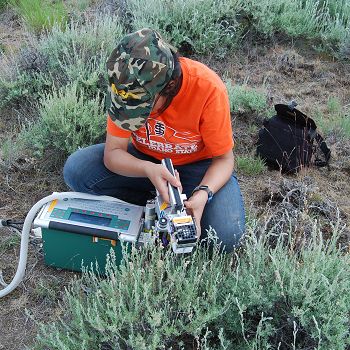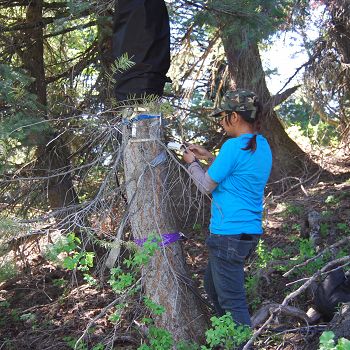Critical Zone Profile – HARMANDEEP SHARMA (ecophysiologist, PhD student)
Harmandeep Sharma was born and raised in the northern part of India in Punjab. She graduated from Punjab Agricultural University in Ludhiana, India with B.S. in Agriculture (Honors). She went on to receive a Masters degree in Plants and Environmental Science from New Mexico State University in 2014. Currently, Sharma works as graduate research assistant at Idaho State University.
“My research focuses on measuring water and carbon fluxes from leaf to ecosystem scales in three sagebrush communities situated along an elevation gradient at Reynolds Creek Critical Zone Observatory in Southwestern Idaho.”- Harmandeep Sharma
Sagebrush steppe ecosystems are one of the most extensive ecosystems in western North America, consisting of several different types of sagebrush communities. These communities survive under various climatic conditions based on their locations using different mechanisms to control carbon and water fluxes. With changes in climate, these communities will also have different responses to such perturbations. Thus, my focus will be to observe fluxes of three different sagebrush communities under varied microclimate conditions and dominant vegetation caused by an elevation gradient. I will also quantify how carbon and water fluxes vary at leaf, plant and ecosystem scales.
These extensive ecosystems also play a significant role in the function of hydrology in water-limited areas. The carbon dynamics are highly coupled with water dynamics, both of which are strongly related to temperature and precipitation regimes (i.e., changes in amount and frequency). Predicting how such dynamics will respond to climatic change is greatly hampered due to a lack of information on the ecophysiological functioning of shrubs. My research is aimed at filling these gaps. I will quantify and compare differences in ecophysiology among subspecies and species of sagebrush in the Reynolds Creek Critical Zone Observatory (RCCZO). The data from this project serves many other purposes, such as improving carbon cycle modeling in semi-arid ecosystems and modeling biosphere-atmosphere exchange of terrestrial ecosystems. Since sagebrush steppe ecosystems are one of the largest carbon pools in the United States, this project will provide us with crucial information for future predictions of the changes in the global carbon cycle.
Ecosystem processes and functions, such as hydrological cycles, geochemical cycles, carbon and water fluxes, etc., all occur within the Critical Zone (CZ). Since CZ structure is a product of tectonic, lithogenic and climatic forces over a long period of time, any alteration due to changing climate conditions will disturb ecological balance, including water and carbon cycles. With the combined effort of scientists working across the CZO network, my research can contribute to understanding uncertainty related to climate change on CZ structure to resolve ecosystem imbalance issues.
The community that has come about from the funding of the CZO network
allows researchers to constantly learn from each other.
The CZO-network has been a great addition to my research project. The availability of massive long-term data sets and CZO infrastructure helps me to develop my research questions effectively. There is great opportunity to share data with experts in your field, to familiarize yourself with other people’s research at CZO annual meetings and workshops, and to learn and implement new ideas. Such a network creates a valuable resource to graduate students and early-career scientists.
The community that has come about from the funding of the CZO network allows researchers to constantly learn from each other in order to improve understanding about CZ function and structure. In addition, education and outreach efforts of the CZOs allow for the continuous sharing of immense and relevant CZO-related knowledge within K-12 classrooms to the general public. My participation in many outreach activities organized by the Reynolds Creek CZO allowed for me to see how much kids enjoy and learn from this CZO-effort.
.
.
.
News Category:
PEOPLE
Related News

Critical Zone Profiles - Meet the people doing CZO science (Reynolds Creek CZO)
18 Jan 2017 - Get a sense of the people and the work. Several members of the Reynolds Creek CZO are profiled here, including students and professors.

Harmandeep Sharma recieved the 2016 New Phytologist Poster Award from ESA
22 Aug 2016 - The Physiological Ecology Section is pleased to announce the 2016 merit award winners for their presentations at the ESA meeting in Ft. Lauderdale.
Explore Further






